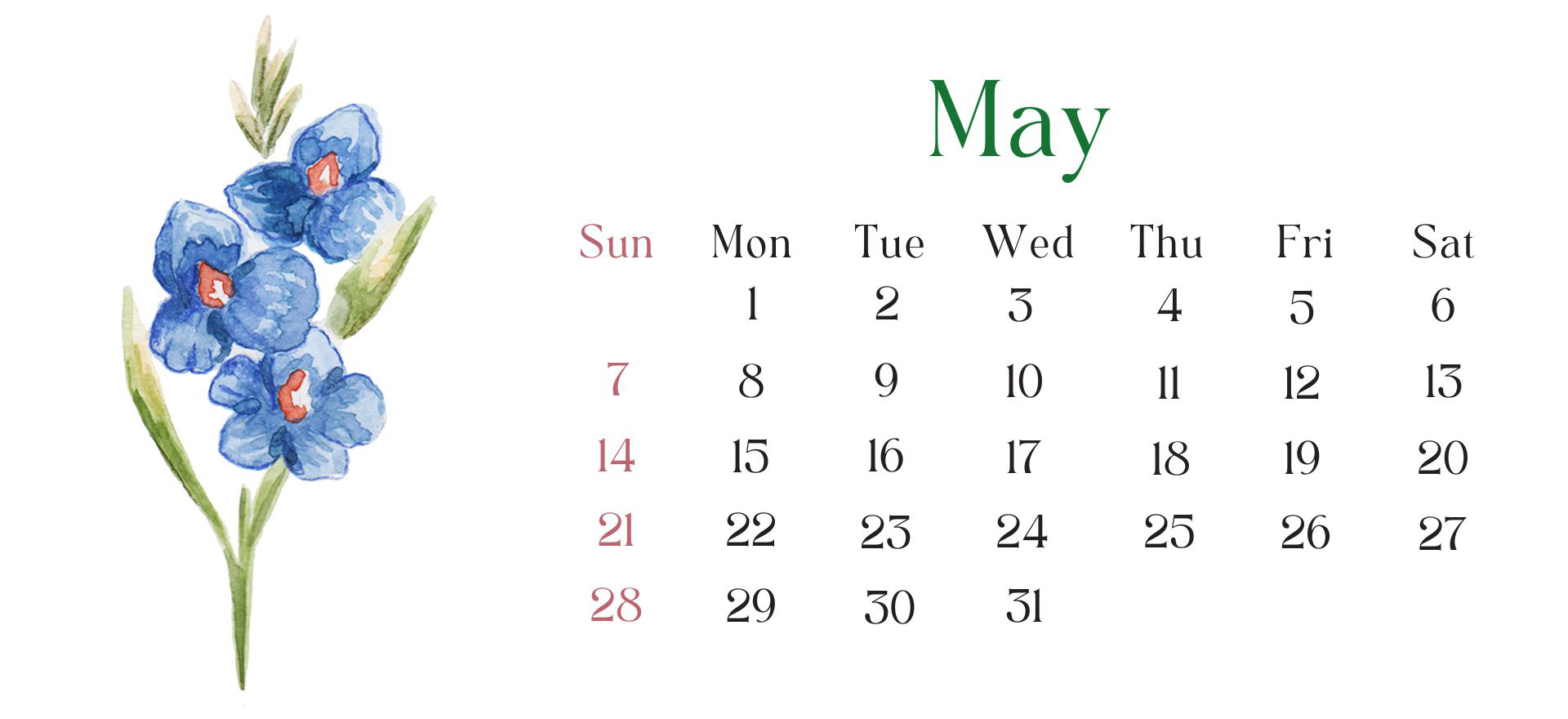
Foraging Calendar: What to Forage in May
April showers bring May flowers, so it’s time to head out and forage for some delicious May forageables. Many plants and flowers are blooming, and as spring heads into full swing, the options of what forageable foods are available to you broaden.
The USDA Hardiness Zone Map is an attempt to divide the country into zones that give us some idea of whether certain plants can be grown in any given area. The primary piece of data used to delineate the zones is the average annual winter temperature experienced in that area. This could just be a list of forageables, but temperature varies so much across the U.S.A. The Lost Herbs wants this to be a list for every one of our readers, no matter the zone you live in.
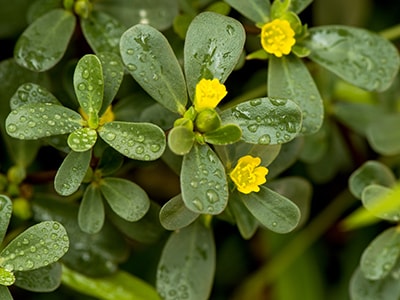 Purslane (Portulaca oleracea) Also known as little hogweed, purslane has fleshy, oval leaves that are shiny and smooth, and small yellow flowers that bloom from mid-summer to fall. It has a slightly sour and salty taste and can be eaten raw in salads, sandwiches, and wraps. Purslane can also be cooked and used in soups, stews, and stir-fries. Recent studies have also shown that it may have anti-inflammatory, antioxidant, and anti-tumor properties. It grows in hardiness zones 5-10.
Purslane (Portulaca oleracea) Also known as little hogweed, purslane has fleshy, oval leaves that are shiny and smooth, and small yellow flowers that bloom from mid-summer to fall. It has a slightly sour and salty taste and can be eaten raw in salads, sandwiches, and wraps. Purslane can also be cooked and used in soups, stews, and stir-fries. Recent studies have also shown that it may have anti-inflammatory, antioxidant, and anti-tumor properties. It grows in hardiness zones 5-10.
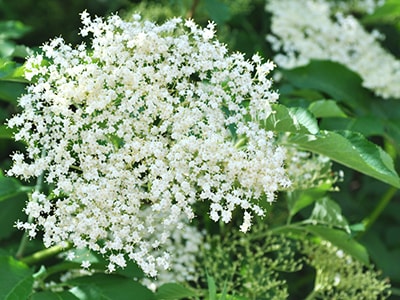 Elderflower (Sambucus nigra) Elder is a deciduous shrub or small tree that produces clusters of dark purple or black berries, called elderberries. The tree is commonly found at heights of 5-12 feet. The leaves are pinnate with 5-9 leaflets that are elliptical in shape, and they have a rough texture on the upper surface. The shrub produces fragrant clusters of small, white or cream-colored flowers (elderflowers) in the spring, followed by clusters of small, dark purple or black berries in the late summer or fall. Elderflower tastes great when added to jams, cakes, tarts, and trifles. It goes especially well with sour fruits like gooseberries and rhubarb. It’s best not to eat elderflowers raw, as the plant has a mild toxicity, which is why it is best to cook them or make cordial from them. They grow in hardiness zones 3-7.
Elderflower (Sambucus nigra) Elder is a deciduous shrub or small tree that produces clusters of dark purple or black berries, called elderberries. The tree is commonly found at heights of 5-12 feet. The leaves are pinnate with 5-9 leaflets that are elliptical in shape, and they have a rough texture on the upper surface. The shrub produces fragrant clusters of small, white or cream-colored flowers (elderflowers) in the spring, followed by clusters of small, dark purple or black berries in the late summer or fall. Elderflower tastes great when added to jams, cakes, tarts, and trifles. It goes especially well with sour fruits like gooseberries and rhubarb. It’s best not to eat elderflowers raw, as the plant has a mild toxicity, which is why it is best to cook them or make cordial from them. They grow in hardiness zones 3-7.
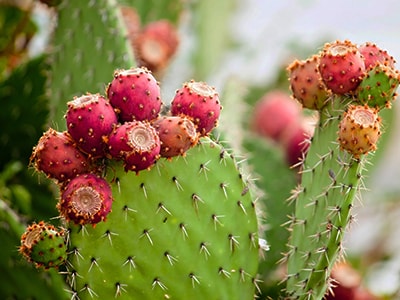 Prickly Pear Cactus (Opuntia spp.) Prickly Pear Cactus is a succulent plant that is native to the Americas. It has flat, paddle-shaped stems that are covered in spines and small, hair-like structures called glochids. The plant can grow up to 16 feet tall, but is more commonly found at heights of 3-6 feet. In the spring, the cactus produces colorful flowers that range in color from yellow to red. The flowers are followed by edible fruit that is often called “tunas”. The fruit is juicy and sweet, and is commonly used to make jams, jellies, and drinks. Prickly pear cactus is a hardy plant that is well-suited for dry, desert-like conditions. It can be found growing in rocky or sandy soils and is often used as a food source and medicine by indigenous peoples in the Americas. The plant has been used to treat a variety of ailments, including digestive problems, skin conditions, and inflammation. They grow in hardiness zones 7-10.
Prickly Pear Cactus (Opuntia spp.) Prickly Pear Cactus is a succulent plant that is native to the Americas. It has flat, paddle-shaped stems that are covered in spines and small, hair-like structures called glochids. The plant can grow up to 16 feet tall, but is more commonly found at heights of 3-6 feet. In the spring, the cactus produces colorful flowers that range in color from yellow to red. The flowers are followed by edible fruit that is often called “tunas”. The fruit is juicy and sweet, and is commonly used to make jams, jellies, and drinks. Prickly pear cactus is a hardy plant that is well-suited for dry, desert-like conditions. It can be found growing in rocky or sandy soils and is often used as a food source and medicine by indigenous peoples in the Americas. The plant has been used to treat a variety of ailments, including digestive problems, skin conditions, and inflammation. They grow in hardiness zones 7-10.
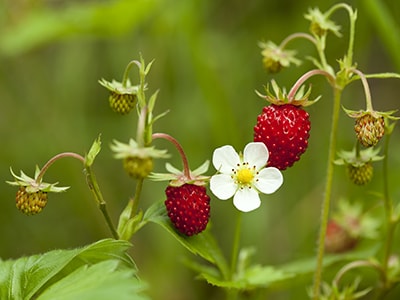 Wild strawberries (Fragaria spp.) Wild strawberries are low-growing, herbaceous plants that produce small, sweet fruits beloved by humans and wildlife alike. Native to temperate regions of the Northern Hemisphere, they have naturalized in other parts of the world as well. Wild strawberry leaves are compound, with three toothed-edge leaflets. In spring, the plants produce small white flowers, followed by the characteristic red fruits in summer. These small, juicy fruits are packed with flavor and can be eaten fresh, used in jams, jellies, or other desserts. Wild strawberries are hardy plants, capable of growing in various soil types and light conditions. Commonly found in fields, meadows, and woodland edges, they can also be easily grown in home gardens. The plant has a long history of use in traditional medicine, treating ailments such as digestive problems, skin conditions, and inflammation. Wild strawberries grow in hardiness zones 3-10.
Wild strawberries (Fragaria spp.) Wild strawberries are low-growing, herbaceous plants that produce small, sweet fruits beloved by humans and wildlife alike. Native to temperate regions of the Northern Hemisphere, they have naturalized in other parts of the world as well. Wild strawberry leaves are compound, with three toothed-edge leaflets. In spring, the plants produce small white flowers, followed by the characteristic red fruits in summer. These small, juicy fruits are packed with flavor and can be eaten fresh, used in jams, jellies, or other desserts. Wild strawberries are hardy plants, capable of growing in various soil types and light conditions. Commonly found in fields, meadows, and woodland edges, they can also be easily grown in home gardens. The plant has a long history of use in traditional medicine, treating ailments such as digestive problems, skin conditions, and inflammation. Wild strawberries grow in hardiness zones 3-10.
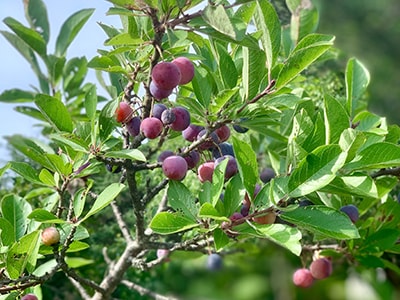 Beach plums (Prunus maritima) Beach plums are deciduous shrubs native to the eastern coast of North America. Typically growing up to 10 feet tall, they more commonly reach heights of 3-6 feet. Beach plum leaves are oval-shaped with slightly serrated edges. In spring, the plants produce small white or pink flowers, followed by distinctive purple-black fruits in late summer or early fall. Approximately 1 inch in diameter, the fruits have a tart, slightly sweet flavor. Beach plums are hardy plants well-suited to sandy, coastal soils, often found along eastern seaboard beaches and dunes. The fruits can be used to make jams, jellies, and other preserves, and are also used to flavor alcoholic beverages like wine and brandy. In addition to culinary uses, beach plums have a long history of use in traditional medicine, treating ailments such as digestive problems and sore throats. They grow in hardiness zones 3-8.
Beach plums (Prunus maritima) Beach plums are deciduous shrubs native to the eastern coast of North America. Typically growing up to 10 feet tall, they more commonly reach heights of 3-6 feet. Beach plum leaves are oval-shaped with slightly serrated edges. In spring, the plants produce small white or pink flowers, followed by distinctive purple-black fruits in late summer or early fall. Approximately 1 inch in diameter, the fruits have a tart, slightly sweet flavor. Beach plums are hardy plants well-suited to sandy, coastal soils, often found along eastern seaboard beaches and dunes. The fruits can be used to make jams, jellies, and other preserves, and are also used to flavor alcoholic beverages like wine and brandy. In addition to culinary uses, beach plums have a long history of use in traditional medicine, treating ailments such as digestive problems and sore throats. They grow in hardiness zones 3-8.
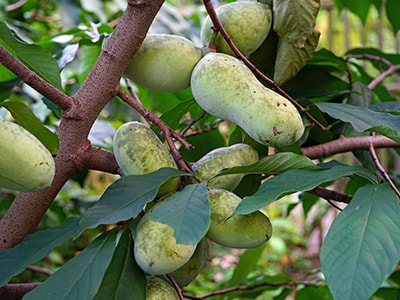 Pawpaw (Asimina triloba) Pawpaw is a deciduous tree native to the eastern United States. It can grow up to 40 feet tall, but more commonly reaches heights of 10-20 feet. Pawpaw leaves are large, simple, and alternate, with slightly wavy edges. In spring, the tree produces small maroon flowers, followed by the characteristic pawpaw fruits in late summer or early fall. These large, oblong fruits have a greenish-yellow skin when ripe, with creamy, custard-like flesh and a sweet, tropical flavor. Pawpaw trees are hardy plants well-suited to moist, fertile soils, often found in wooded areas’ understory, serving as an essential food source for various wildlife. The fruits can be eaten fresh, used in desserts and other culinary creations, and also used in traditional medicine to treat ailments like fever, infections, and digestive problems. They grow in hardiness zones 5-8.
Pawpaw (Asimina triloba) Pawpaw is a deciduous tree native to the eastern United States. It can grow up to 40 feet tall, but more commonly reaches heights of 10-20 feet. Pawpaw leaves are large, simple, and alternate, with slightly wavy edges. In spring, the tree produces small maroon flowers, followed by the characteristic pawpaw fruits in late summer or early fall. These large, oblong fruits have a greenish-yellow skin when ripe, with creamy, custard-like flesh and a sweet, tropical flavor. Pawpaw trees are hardy plants well-suited to moist, fertile soils, often found in wooded areas’ understory, serving as an essential food source for various wildlife. The fruits can be eaten fresh, used in desserts and other culinary creations, and also used in traditional medicine to treat ailments like fever, infections, and digestive problems. They grow in hardiness zones 5-8.
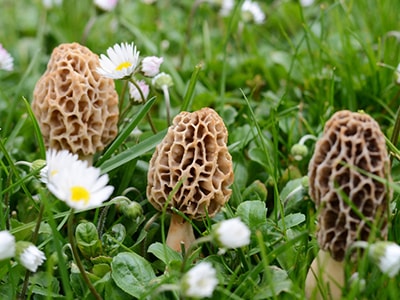 True Morels (Morchella). Morel mushrooms are distinctive-looking due to their cone-shaped cap and sponge-like texture. Caps range in color from pale cream to almost black, with a pitted, honeycomb texture. Morels are hollow, stand two to four inches tall (when completely developed, some species are six inches tall), and have a white or cream stem. Morels are most commonly found in woodlands or woody edges. Morels grow under or around decaying elms, ash, poplar and apple trees. Other preferred sites include south facing slopes, burned (forest fire) or logged woodlands and disturbed areas. The most commonly misidentified mushroom that mushroom hunters find when looking for morels is the false morel, which is poisonous.
True Morels (Morchella). Morel mushrooms are distinctive-looking due to their cone-shaped cap and sponge-like texture. Caps range in color from pale cream to almost black, with a pitted, honeycomb texture. Morels are hollow, stand two to four inches tall (when completely developed, some species are six inches tall), and have a white or cream stem. Morels are most commonly found in woodlands or woody edges. Morels grow under or around decaying elms, ash, poplar and apple trees. Other preferred sites include south facing slopes, burned (forest fire) or logged woodlands and disturbed areas. The most commonly misidentified mushroom that mushroom hunters find when looking for morels is the false morel, which is poisonous.
⇒ How to Make Bark Bread from a Tree That Grows on Almost Every Street in America (Video)
While all of these are located in the US., we don’t want to leave our overseas readers out of the loop. Countries like Canada and Australia are also abundant with delicious plants.
Canada’s weather aligns more with the United States and many of the plants above can grow in Canada’s ecosystem. Canadians can use the hardiness zones to apply to their regions.
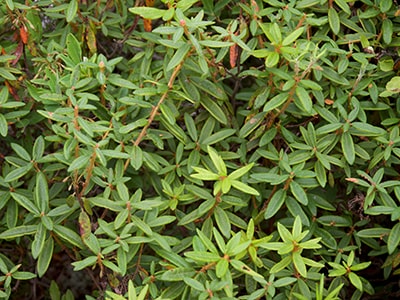 Labrador tea (Rhododendron groenlandicum) Labrador tea is an evergreen shrub that thrives in the cold climates of Canada, Alaska, and Greenland. This low-growing plant has dark green, leathery leaves with fuzzy, rust-colored undersides, and clusters of small, white flowers that bloom in late spring or early summer. Found in boggy areas and damp forests, Labrador tea has been used by Indigenous peoples for centuries to make a calming, aromatic herbal tea. The leaves contain essential oils that provide various medicinal properties, such as alleviating cold symptoms, soothing sore throats, and aiding digestion. Labrador tea grows best in acidic, moist soils and can be found in hardiness zones 2-6.
Labrador tea (Rhododendron groenlandicum) Labrador tea is an evergreen shrub that thrives in the cold climates of Canada, Alaska, and Greenland. This low-growing plant has dark green, leathery leaves with fuzzy, rust-colored undersides, and clusters of small, white flowers that bloom in late spring or early summer. Found in boggy areas and damp forests, Labrador tea has been used by Indigenous peoples for centuries to make a calming, aromatic herbal tea. The leaves contain essential oils that provide various medicinal properties, such as alleviating cold symptoms, soothing sore throats, and aiding digestion. Labrador tea grows best in acidic, moist soils and can be found in hardiness zones 2-6.
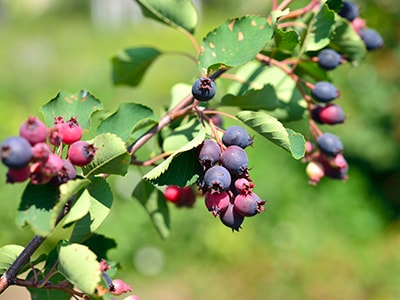 Saskatoon berry (Amelanchier alnifolia) Saskatoon berry, also known as serviceberry or juneberry, is a deciduous shrub or small tree native to North America. It grows between 3-18 feet tall, featuring oval-shaped leaves, clusters of small white flowers in the spring, and small, purple-blue, berry-like fruits in the summer. The fruits resemble blueberries in appearance and taste, offering a sweet and slightly nutty flavor. Saskatoon berries are a rich source of vitamins, minerals, and antioxidants, making them a nutritious and tasty addition to pies, jams, syrups, and smoothies. The plant is adaptable to a variety of soil conditions and is found in hardiness zones 2-7.
Saskatoon berry (Amelanchier alnifolia) Saskatoon berry, also known as serviceberry or juneberry, is a deciduous shrub or small tree native to North America. It grows between 3-18 feet tall, featuring oval-shaped leaves, clusters of small white flowers in the spring, and small, purple-blue, berry-like fruits in the summer. The fruits resemble blueberries in appearance and taste, offering a sweet and slightly nutty flavor. Saskatoon berries are a rich source of vitamins, minerals, and antioxidants, making them a nutritious and tasty addition to pies, jams, syrups, and smoothies. The plant is adaptable to a variety of soil conditions and is found in hardiness zones 2-7.
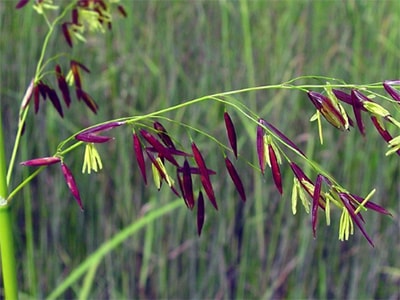 Wild rice (Zizania palustris) Wild rice is an aquatic grass native to North America, flourishing in shallow waters or along muddy shores. This plant displays long, slender leaves that can reach up to 10 feet in length and produce small, brownish flowers. The grains of wild rice are elongated, slender, and vary in color from black to brown. Serving as a vital traditional food source for Native American communities, wild rice is also commercially cultivated and used in global culinary dishes. Typically found in wetlands, rivers, and lakes throughout the northern United States and Canada, wild rice boasts a nutty flavor and chewy texture. It can be incorporated into various recipes, such as soups, salads, and stuffings, offering a rich source of protein, fiber, and minerals. Wild rice plants thrive in hardiness zones 2-10.
Wild rice (Zizania palustris) Wild rice is an aquatic grass native to North America, flourishing in shallow waters or along muddy shores. This plant displays long, slender leaves that can reach up to 10 feet in length and produce small, brownish flowers. The grains of wild rice are elongated, slender, and vary in color from black to brown. Serving as a vital traditional food source for Native American communities, wild rice is also commercially cultivated and used in global culinary dishes. Typically found in wetlands, rivers, and lakes throughout the northern United States and Canada, wild rice boasts a nutty flavor and chewy texture. It can be incorporated into various recipes, such as soups, salads, and stuffings, offering a rich source of protein, fiber, and minerals. Wild rice plants thrive in hardiness zones 2-10.
Australia lies in Plant Hardiness Zones 7 through 12 with some variations across regions and seasons. The caveat with foraging in Australia is it is completely illegal without a permit except private properties in some places. Without the 104$ permit you can be fined anywhere from 10,000 to 110,000 dollars depending on where you foraged. If you have a license or are on your own land you can forage freely.
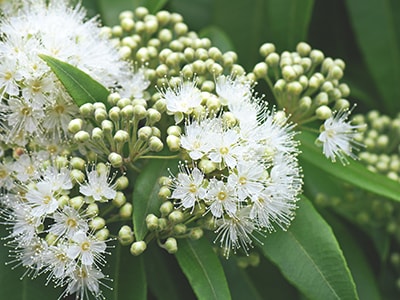 Lemon Myrtle (Backhousia citriodora) Lemon Myrtle is an evergreen tree or shrub native to Australia. The plant has glossy, dark green leaves that are highly fragrant and contain essential oils that give off a strong lemony aroma. The plant produces small white or cream-colored flowers that bloom in the spring and summer. Lemon myrtle is used in a variety of culinary dishes, such as teas, syrups, cakes, and marinades, and is also used in skincare products and essential oils. The plant is cultivated for commercial use in Australia and can also be grown in other subtropical or tropical regions. Lemon myrtle is a rich source of antioxidants and has antimicrobial and anti-inflammatory properties. It is a popular ingredient in traditional medicine and is used to treat a variety of ailments such as colds, flu, and digestive issues. Lemon myrtle grows in hardiness zones 9-11.
Lemon Myrtle (Backhousia citriodora) Lemon Myrtle is an evergreen tree or shrub native to Australia. The plant has glossy, dark green leaves that are highly fragrant and contain essential oils that give off a strong lemony aroma. The plant produces small white or cream-colored flowers that bloom in the spring and summer. Lemon myrtle is used in a variety of culinary dishes, such as teas, syrups, cakes, and marinades, and is also used in skincare products and essential oils. The plant is cultivated for commercial use in Australia and can also be grown in other subtropical or tropical regions. Lemon myrtle is a rich source of antioxidants and has antimicrobial and anti-inflammatory properties. It is a popular ingredient in traditional medicine and is used to treat a variety of ailments such as colds, flu, and digestive issues. Lemon myrtle grows in hardiness zones 9-11.
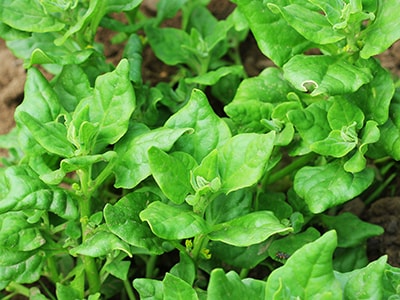 Warrigal greens (Tetragonia tetragonioides) Warrigal greens are a nutritious leafy green plant found in coastal regions of Australia and New Zealand. This trailing or climbing plant produces dark green, glossy, triangular or arrow-shaped leaves with a slightly salty taste. Warrigal greens are high in vitamins and minerals, especially vitamin C and iron, and have been used for food and medicinal purposes by indigenous peoples for centuries. Warrigal greens are a great addition to foraging, and can be cooked and used in a variety of dishes such as stir-fries, quiches, and soups, providing a tasty and nutritious option for wild foragers. These greens can be found in temperate, subtropical, and tropical regions, and they grow well in hardiness zones 8-11.
Warrigal greens (Tetragonia tetragonioides) Warrigal greens are a nutritious leafy green plant found in coastal regions of Australia and New Zealand. This trailing or climbing plant produces dark green, glossy, triangular or arrow-shaped leaves with a slightly salty taste. Warrigal greens are high in vitamins and minerals, especially vitamin C and iron, and have been used for food and medicinal purposes by indigenous peoples for centuries. Warrigal greens are a great addition to foraging, and can be cooked and used in a variety of dishes such as stir-fries, quiches, and soups, providing a tasty and nutritious option for wild foragers. These greens can be found in temperate, subtropical, and tropical regions, and they grow well in hardiness zones 8-11.
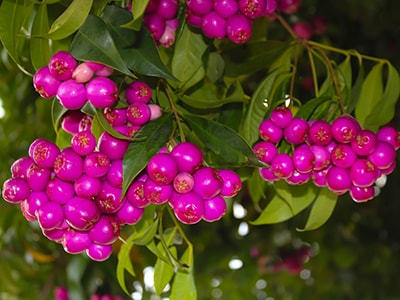 Riberry (Syzygium luehmannii) Riberry is a small evergreen tree or shrub that is native to Australia. This plant produces clusters of small, round, purple-red berries that are packed with flavor and nutrition. The berries have a tart and slightly sweet taste with a clove-like aroma, making them a popular ingredient in jams, sauces, and desserts. The leaves of the riberry plant can also be used in tea and as a flavoring agent. Riberry plants thrive in subtropical and tropical regions, and are hardy in zones 10 to 11. Foragers can find riberry plants growing in their natural habitat, typically in moist areas such as rainforests, along streams and riverbanks. The delicious and versatile riberry is a great choice for foragers who want to add a unique flavor to their culinary creations.
Riberry (Syzygium luehmannii) Riberry is a small evergreen tree or shrub that is native to Australia. This plant produces clusters of small, round, purple-red berries that are packed with flavor and nutrition. The berries have a tart and slightly sweet taste with a clove-like aroma, making them a popular ingredient in jams, sauces, and desserts. The leaves of the riberry plant can also be used in tea and as a flavoring agent. Riberry plants thrive in subtropical and tropical regions, and are hardy in zones 10 to 11. Foragers can find riberry plants growing in their natural habitat, typically in moist areas such as rainforests, along streams and riverbanks. The delicious and versatile riberry is a great choice for foragers who want to add a unique flavor to their culinary creations.
The bounty of nature is in full swing, so it’s time to get out there and find what the earth has to offer us. It’s time to get our best gathering done now while we can before the summer heat hits, and with simple groceries becoming more and more expensive at the marketplace, these fresh forages can help you prepare for an easier summer.

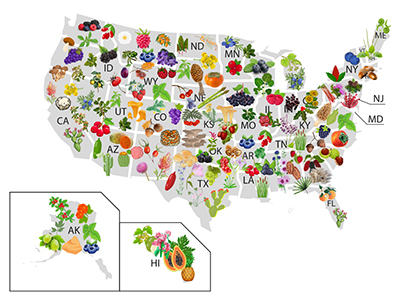
Thank you a lot for with another healthy, nature
Information.
Best of Health and Blessings!!
Hi Eva,
Thank you so much for your kind feedback!
It is much appreciated.
Many blessings and good health!
so interesting thank you
Hi Emma,
Thank you so much for your kind words!
We’re glad to hear you find our articles interesting.
Many blessings and good health!
What about your cousin’s in the UK, please don’t forget us on the list.
Hi Elizabeth,
Thank you for your interest in our articles!
These are some of the forageables you can find this time of the year in the UK: Dandelions, Oxeye Daisy, Borage, Cow parsley, Elderflower, Sorrel, or Cuckooflower. Let us know what other wild edibles you find.
Happy foraging!
Thank you for all the wonderful information! I am truly enjoying your books that I ordered!
Hi Paula,
Thank you so much for your kind feedback!
We’re happy to hear the books are helpful for you.
Many blessings and good health!
Hi Lovely,
Is there any chance you could create a Southern Hemisphere calander where the months are flipped for our seasons?
I’m in Australia
Thank you
Julz
I was going to order this book for a second time and it turns out you are very popular with the better business bureau. I think you have some problems getting customers their orders